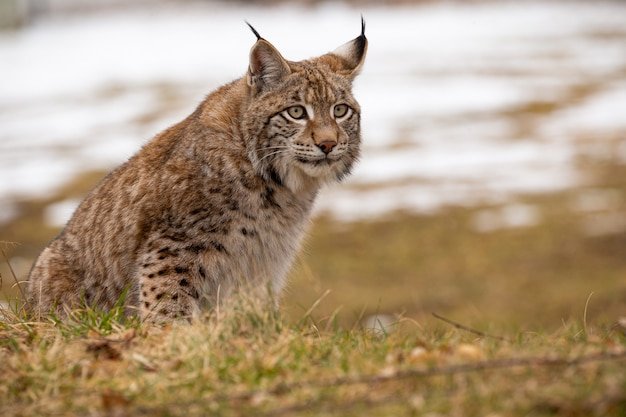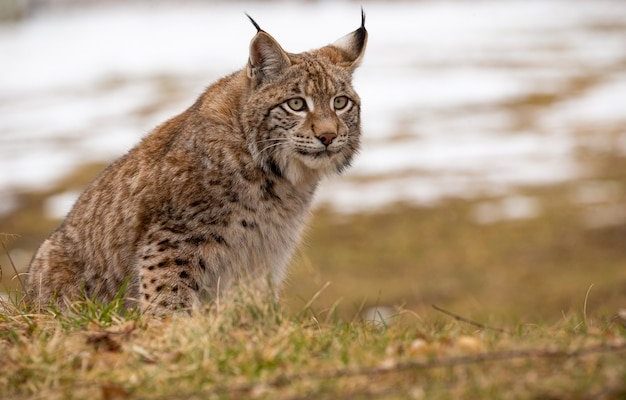
Let’s dig deeper into the unique characteristics that allow these fascinating creatures to endure and even flourish where many other animals struggle. Think of it like unraveling a beautiful tapestry, each thread representing a skill or trait that helps lynxes navigate their challenging environments. By the end, you’ll appreciate the lynx not just for its beauty, but for the incredible survival skills it showcases in the wild.
Adaptations to Cold Weather
Lynx are built for cold climates. Their thick fur acts as insulation, keeping them warm even during the harshest winters. This fur is especially dense around their paws, which creates a natural snowshoe effect, allowing them to walk on top of the snow rather than sinking into it. You might be wondering how this helps them hunt. Well, being able to move quietly and effortlessly across the snow gives them a crucial advantage when stalking prey.
Another critical adaptation is their large, tufted ears. These aren’t just for looks—they enhance their hearing. In a winter landscape, where sounds can be muffled, having heightened auditory senses helps them detect the movements of prey hidden beneath the snow. Imagine trying to locate a hidden snack while wearing earplugs; you’d need all the help you could get!
Lynx also have a unique ability to stay warm by slowing down their metabolism during extremely cold spells. This means they use less energy, which is essential when food might be scarce. When you think about survival, it’s these kinds of adaptations—large ears for hearing, thick fur for warmth, and a savvy approach to food management—that illustrate how lynxes thrive in tough conditions.
Hunting Skills and Diet
When it comes to hunting, lynxes are expert predators. They primarily prey on snowshoe hares, but their diet can also include birds, rodents, and even young deer. The lynx’s strategy involves a mix of stealth and patience. They often wait quietly under a tree or bush, observing their surroundings before making a move. This calculated approach is vital because, in the snowy wilderness, meals can be few and far between.
One fascinating aspect of lynx hunting is their ability to use their surroundings to their advantage. For instance, they can leap through deep snow to surprise unsuspecting prey. Think of a sniper waiting patiently, then striking with precision; that’s how lynxes operate. They’re not just random hunters; they’ve got a game plan that maximizes their chances of success.
Moreover, during the harshest winters, lynxes may need to travel long distances to find food. Their large territories range from 10 to 100 square miles, depending on the availability of prey. This means they’re constantly moving, searching for the next meal. In this way, they embody both the tenacity to survive and the adaptability to thrive over vast landscapes where others might give up.
Camouflage and Terrain Navigation
Lynx are masters of disguise. Their coat changes slightly with the seasons, allowing them to blend seamlessly into their snowy surroundings. In winter, their fur takes on a light hue, while in summer, it darkens to match the forest floor. This clever camouflage is essential for both hunting and avoiding larger predators.
When it comes to navigating their often rugged terrain, lynx are incredibly agile. Their long legs and flexible joints allow them to move easily over rocky surfaces and through dense underbrush. Ever tried sprinting through a dense forest? It’s tricky! Lynxes, however, can zigzag and weave between trees and boulders with grace, making it look effortless.
Their keen eyesight also plays a role in how they navigate and hunt. Lynx can see very well in low light, which is especially beneficial during the long nights of winter. Picture being out in the dark and being able to spot every movement; that’s the lynx for you!
Reproduction and Survival of Young
Breeding season for lynx usually occurs between February and April. After a gestation period of about two months, the mother gives birth to a litter of two to four kittens. These adorable little furballs are not only cute; they represent the future of their species. The early weeks are critical for survival, as they are born blind and completely dependent on their mother.
Lynx mothers are incredibly protective, often moving their young to different den sites to avoid danger. During this time, they share the responsibility of hunting with the kittens taking notes from their mother’s techniques. Imagine a parent teaching their child how to cook—lynx mothers are doing the same but in the wild.
As the kittens grow older, they learn essential survival skills through play and observation. They mimic hunting techniques, practicing pouncing and stalking around their den. By the time they leave their mother at around 10 months, they’re equipped with the know-how to thrive on their own in the tough environments they call home.
Impact of Climate Change
Unfortunately, lynxes face new challenges due to climate change. As temperatures rise and snow becomes less predictable, their habitats are affected. The snowshoe hares they depend on are also impacted, forcing lynxes to adapt even further. Here’s the thing: when environments change rapidly, animals that can’t keep up risk losing their homes and food sources.
Moreover, as human activity encroaches on their territories, lynxes find themselves in more conflict with people. Roads and urban areas can fragment their habitats, making it harder to find food and mates. This loss of connectivity is something many species face today, and it’s a crucial issue for conservation efforts.
In a world where things are changing fast, understanding how lynx adapt to harsh environments is more important than ever. By studying their behaviors and requirements, we can work towards preserving their habitats and ensuring these beautiful creatures continue to thrive.
Conservation Efforts
Thankfully, several conservation efforts focus on protecting lynx habitats. Organizations and wildlife agencies are actively working to create wildlife corridors, which are safe passages for lynx and other animals to navigate between fragmented habitats. These corridors help maintain genetic diversity and healthy populations.
Education is also key. Raising awareness about the importance of lynxes in the ecosystem encourages more people to support conservation initiatives. You might be surprised to learn that lynx play a crucial role in controlling hare populations, which helps maintain a balanced ecosystem. When you think about it, every creature has its part to play in the grand design of nature.
Community involvement is vital too. Local residents can help by reporting sightings, participating in habitat restoration projects, and advocating for policies that protect these incredible animals. When everyone pitches in, we can enhance the chances of survival for lynx and many other species facing similar threats.
In conclusion, lynxes are remarkable survivors, perfectly adapted to their harsh environments. From their thick fur to their stealthy hunting techniques, they embody resilience in the face of adversity. As we learn more about them, it’s crucial to remember the role we can play in ensuring their continued existence. By respecting their habitats and supporting conservation efforts, we can contribute to a future where lynxes—those magnificent creatures—continue to roam the snowy landscapes they call home.

